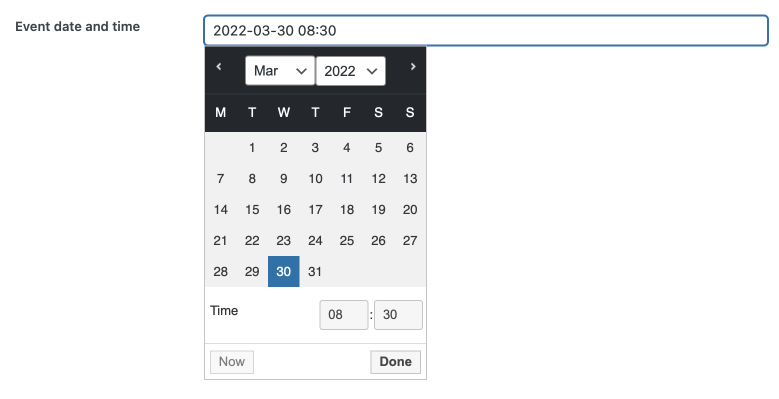Datetime
The datetime field allows you to select a date and time via a friendly UI. This field uses jQuery UI date & time picker libraries.
Screenshots


Settings
Besides the common settings, this field has the following specific settings, the keys are for use with code:
| Name | Key | Description |
|---|---|---|
| Size of the input box | size | Size of the input box. Optional. Default 10. Without this setting, the input box is full-width. |
| Inline | inline | Whether to display the date picker inline with the input and don't require to click to show the date picker? true or false (default). |
| Save value as timestamp | timestamp | Whether to save the date in the Unix timestamp format (but still display in human-readable format)? true or false (default). |
| Date picker options | js_options | Date and picker options. See date picker options and time picker options. |
| Save format | save_format | Custom PHP format for the datetime saved in the custom fields. See here. |
This field gets the current time of your local computer and converts it to the timestamp value. So the Unix timestamp saved is the "timezone (UTC) + offset".
This is a sample field settings array when creating this field with code:
[
'name' => 'Date picker',
'id' => 'field_id',
'type' => 'datetime',
'js_options' => [
'stepMinute' => 15,
'showTimepicker' => true,
'controlType' => 'select',
'showButtonPanel' => false,
'oneLine' => true,
],
'inline' => false,
'timestamp' => false,
],
Data
If the timestamp is set to true, the field value is converted to Unix timestamp and saved to the database. Otherwise, the user input value is saved.
Saving dates in another format
Meta Box already supports customizing the date format displaying to users via js_options. For example, you can set it to dd-mm-yy.
However, you might want to save the date in another format, like Y-m-d, which allows you to sort or query posts by date. To do that, set the value of "Save format" to "Y-m-d".
If you use code, then the field settings will look like this:
[
'js_options' => [
'dateFormat' => 'dd-mm-yy',
],
'save_format' => 'Y-m-d',
],
So when displaying to users, the date will have the format of 30-01-2019, and when saving to the database, it will have the format of 2019-01-30.
Template usage
Displaying the value:
<p>Entered: <?php rwmb_the_value( 'my_field_id' ) ?></p>
Getting the value:
<?php $value = rwmb_meta( 'my_field_id' ) ?>
<p>Entered: <?= $value ?></p>
Converting timestamp to another format:
If you save the field value as a timestamp, then you can convert the value to different format, like this:
<?php $value = rwmb_meta( 'my_field_id' ) ?>
<p>Event date: <?= date( 'F j, Y', $value ) ?></p>
Or simpler:
<p>Event date: <?php rwmb_the_value( 'my_field_id', ['format' => 'F j, Y'] ) ?></p>
The 2nd parameter of rwmb_the_value() accepts and extra parameter "format" which specify the datetime format to output in the frontend.
Querying posts by date:
Saving values in timestamp allows you to query posts with a specific order by this field:
$query = new WP_Query( [
'post_type' => 'event',
'orderby' => 'meta_value_num',
'meta_key' => 'my_field_id',
'order' => 'ASC',
] );
However, you still can sort posts by meta value if you set date format to something similar to yy-mm-dd. Anyway, querying posts by custom fields is not recommended.